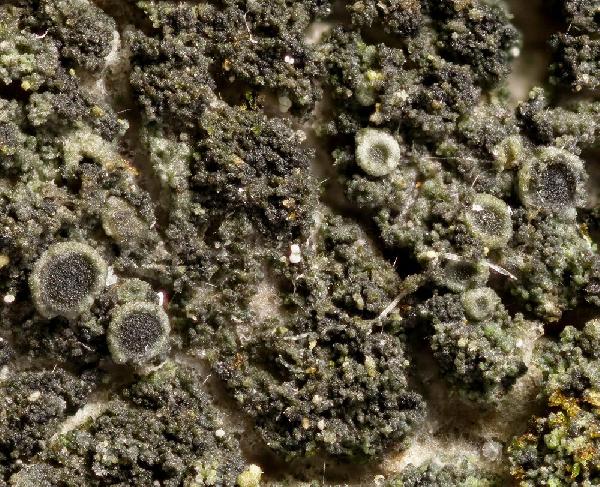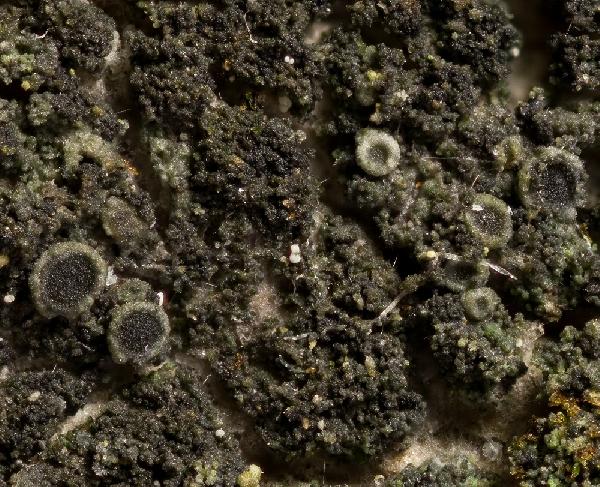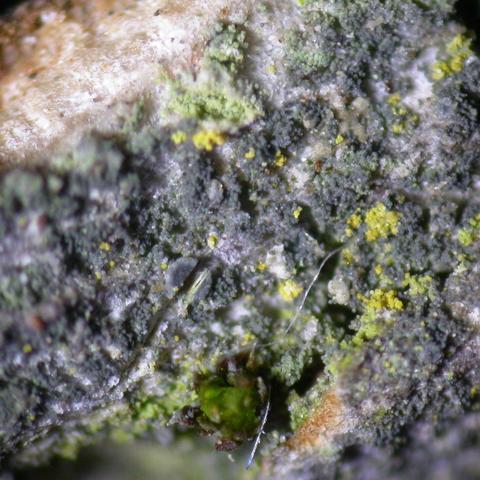Rinodina pityrea Ropin & H. Mayrhofer
Bibl. Lichenol., 58: 374, 1995.
Synonyms: Rinodina leprosa var. lecideina A. Massal.; Rinodina leprosa var. lecideina f. capniochroa A. Massal.; Rinodina leprosa var. lecideina f. fuliginea A. Massal.
Distribution: N - Ven (Lazzarin 2000, 2000b, Obermayer 2011), Emil (Ropin & Mayrhofer 1995, Fariselli & al. 2020). C - Sar (Ropin & Mayrhofer 1995). S - Cal (Nascimbene & al. 2021).
Description: Thallus crustose, endosubstratic or thinly episubstratic, sometimes poorly evident, dark grey, blue-grey or almost black, continuous to rimose, without a distinct prothallus, covered with irregular patches of blue-green to dark blue-grey, up to 30 µm wide blastidia. Apothecia rare, lecanorine, 0.3-0.7 mm across, broadly attached, with a black, flat to convex disc, and a thick, smooth to granulose-blastidiate thalline margin. Thalline exciple corticate, the cortex 15-30 µm thick, grey in outer part, colourless within, the pigmented part K+ and N+ violet; epithecium dark blue-grey or greenish grey, 10-15 µm high, K+ violet; hymenium colourless, not inspersed with oil droplets, (70-)80-90(-95) µm high; paraphyses simple or sparingly branched, the apical cell swollen, 3-5 µm wide; hypothecium colourless or yellowish, up to 90(-115) µm high. Asci 8-spored, clavate, the K/I+ blue tholus penetrated by a faintly amyloid apical cushion with parallel or diverging flanks, the wall K/I-, surrounded by a K/I+ blue outer layer, Lecanora-type. Ascospores 1-septate, brown, (12.5-)14-21(-23.5) x (5-)7-9(-12) µm, thick- and double-walled, Tunicata-type, the wall strongly warted, with ontogeny of type A (apical wall thickening after septum formation). Pycnidia black, immersed. Conidia bacilliform, 5-7 x 1-2 µm. Photobiont chlorococcoid. Spot tests: thallus K-, C-, KC-, P-, but thick sections reacting fleeting K+, C+ and N+ violet. Chemistry: Sedifolia-grey pigment in thallus and epithecium. Note: a temperate species found on asbestos-cement and mortar, often on walls, more rarely on dust-impregnated bark; certainly more widespread, but easy to overlook, being often sterile.
Growth form: Crustose
Substrata: rocks
Photobiont: green algae other than Trentepohlia
Reproductive strategy: mainly asexual, by soredia, or soredia-like structures (e.g. blastidia)
Most common in areas with a humid-warm climate (e.g. most of Tyrrenian Italy)
Commonnes-rarity: (info)
Alpine belt: absent
Subalpine belt: absent
Oromediterranean belt: absent
Montane belt: absent
Submediterranean belt: very rare
Padanian area: absent
Humid submediterranean belt: rare
Humid mediterranean belt: rare
Dry mediterranean belt: absent

Predictive model
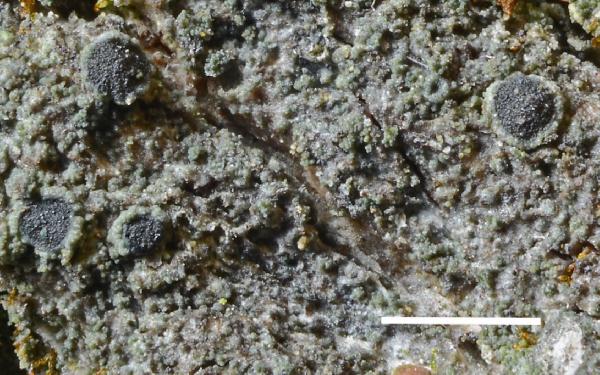
Source: Arup, U. & Ligander, I. 2023. Phylogeny, ecology and morphology of the two corticolous lichen species Rinodina colobina and R. pityrea in the Nordic countries. Graphis Scripta 35 (8): 126–143. Oslo. ISSN 2002- 4495. - CC BY-4.0
Rinodina pityrea specimen from Svedberga kulle, Skåne, Sweden. It has a thick blue-green layer of
≤25–50 μm large blastidia and apothecia with a crenulate–crumbling thalline margin and flat to convex disc
with a visible proper excipulum. Ligander 21-2 (LD).
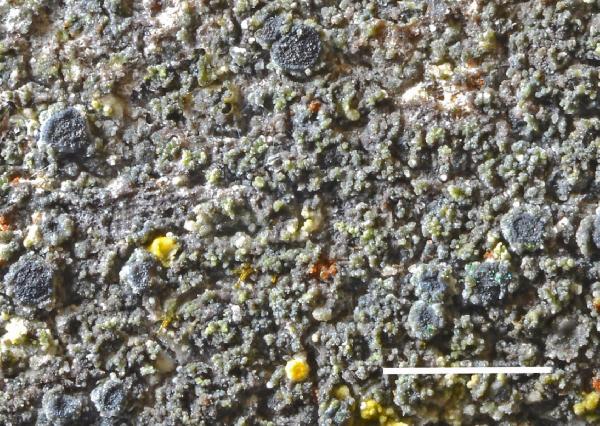
Source: Arup, U. & Ligander, I. 2023. Phylogeny, ecology and morphology of the two corticolous lichen species Rinodina colobina and R. pityrea in the Nordic countries. Graphis Scripta 35 (8): 126–143. Oslo. ISSN 2002- 4495. - CC BY-4.0
Thallus with apothecia of Rinodina pityrea specimen in Engsö in Sweden. The thallus is visibly
blastidiate and the thalline exciple is crenulate to crumbling and consist of blastidia, with a proper excipulum
clearly visible. Ligander 21-1 (LD)
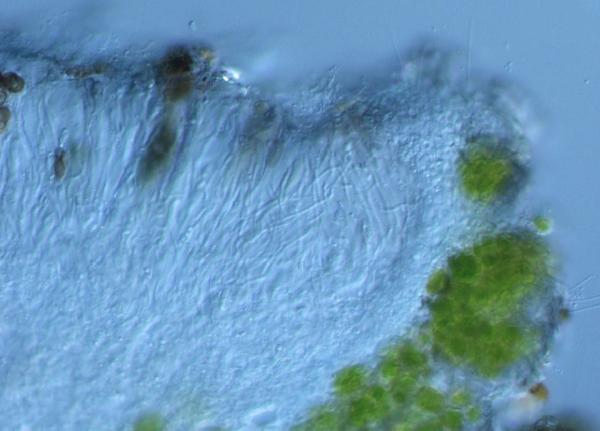
Source: Arup, U. & Ligander, I. 2023. Phylogeny, ecology and morphology of the two corticolous lichen species Rinodina colobina and R. pityrea in the Nordic countries. Graphis Scripta 35 (8): 126–143. Oslo. ISSN 2002- 4495. - CC BY-4.0
Cross section of Rinodina pityrea apothecium. The fairly well developed proper excipulum can be
seen as thin layer coming from the base of the apothecium between the hymenium and the crumbling thalline
margin. Ligander 21-1 (LD)
Growth form: Crustose
Substrata: rocks
Photobiont: green algae other than Trentepohlia
Reproductive strategy: mainly asexual, by soredia, or soredia-like structures (e.g. blastidia)
Most common in areas with a humid-warm climate (e.g. most of Tyrrenian Italy)
Commonnes-rarity: (info)
Alpine belt: absent
Subalpine belt: absent
Oromediterranean belt: absent
Montane belt: absent
Submediterranean belt: very rare
Padanian area: absent
Humid submediterranean belt: rare
Humid mediterranean belt: rare
Dry mediterranean belt: absent

Predictive model

Source: Arup, U. & Ligander, I. 2023. Phylogeny, ecology and morphology of the two corticolous lichen species Rinodina colobina and R. pityrea in the Nordic countries. Graphis Scripta 35 (8): 126–143. Oslo. ISSN 2002- 4495. - CC BY-4.0
Rinodina pityrea specimen from Svedberga kulle, Skåne, Sweden. It has a thick blue-green layer of ≤25–50 μm large blastidia and apothecia with a crenulate–crumbling thalline margin and flat to convex disc with a visible proper excipulum. Ligander 21-2 (LD).

Source: Arup, U. & Ligander, I. 2023. Phylogeny, ecology and morphology of the two corticolous lichen species Rinodina colobina and R. pityrea in the Nordic countries. Graphis Scripta 35 (8): 126–143. Oslo. ISSN 2002- 4495. - CC BY-4.0
Thallus with apothecia of Rinodina pityrea specimen in Engsö in Sweden. The thallus is visibly blastidiate and the thalline exciple is crenulate to crumbling and consist of blastidia, with a proper excipulum clearly visible. Ligander 21-1 (LD)

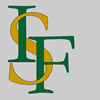 Index Fungorum
Index Fungorum
 GBIF
GBIF
